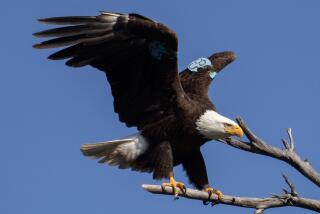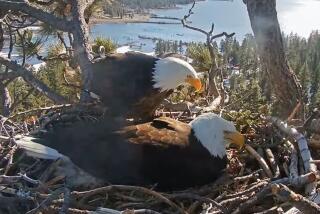Condor Hatched at Park After 63 Hours of Pecking
Mandan, the second California condor to be conceived and born in captivity, is sleeping peacefully after its 63-hour pecking ordeal Wednesday, officials at the San Diego Wild Animal Park said.
The bird began its entry into the world at 11 p.m. Sunday, when it “pipped,” said Tom Hanscom, spokesman at the Wild Animal Park. The chick hatched at 2:02 p.m. Wednesday.
“Experience shows that (the bird) will hatch between 60 and 72 hours after the ‘pip,’ or the point at which the chick pokes an air hole,” Hanscom said. “It leaves the shell quite exhausted by the hatch process. We help quite a bit. We basically chip half to two-thirds of the shell away, small piece by piece, until more or less we can turn the egg and pull it free.”
The chick, which hatched after 57 days of incubation, is resting after undergoing minor surgery for a stomach opening after the hatching.
The opening usually closes itself in a few hours, Hanscom said, but because it is a condor, officials wanted to take extra precautions.
“Sometimes, the hole is wide. We wanted no opportunity for the introduction of infection,” Hanscom said. “We gave it a stitch or two to make sure it was closed to the point that infection does not have the opportunity to enter the bird’s body.”
Surgery Often Necessary
Mike Cunningham, assistant curator of birds at the Los Angeles Zoo, said surgery is often necessary to remove unused portions of the yolk sac, to which the bird’s umbilical cord is attached, if a chick is hatched too soon.
Hanscom said that park officials are careful to go slow.
“If hatching were rushed, it would hold the threat of blood vessel breakage. We want to hatch it after the blood vessels are internalized but before the bird has overexerted itself physically.”
Hanscom said that they won’t know if Mandan is a male or female for another six to eight weeks, when they will perform blood tests.
“It’s a small, inactive chick, has hair-like feathers which are matted down by the albumen still present from the egg and the water, which we spray on the chick to keep it loosened within the shell. It will begin to fluff up in about a day, and it will show a great deal of activity,” he said.
Hanscom added that the digestive functions of the bird will be closely monitored. It will be given its first meal--minced mice mixed with egg yolk--today, and will be hand-fed for the first two days before being raised by condor-like puppets.
The chick was named by California Department of Fish and Game biologists after the American Indian tribe native to the eastern Rockies, Hanscom said. Mandan is the sibling of Molloko, the chick born to UN-1 and AC-4 in March 1988. The pair also laid an egg April 9, which was found to be fertile a few days later and is expected to hatch in early June.
Seven eggs have been laid by condors this year: Four were fertile, two were infertile and one was broken in the nest.
The remaining condors, which now total 29, are divided between the Los Angeles Zoo and the Wild Animal Park. They are part of a breeding program to replenish the nearly extinct species by eventually releasing the huge birds into the California condor range.
More to Read
Sign up for Essential California
The most important California stories and recommendations in your inbox every morning.
You may occasionally receive promotional content from the Los Angeles Times.








